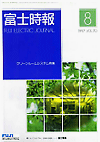FUJI ELECTRIC JOURNAL Vol.70-No.8 (Aug/1997)
 |
Clean Room Systems |
Present Status and Prospects for Clean Room Systems
Hiroyuki Yokomaku, Nobuyuki Suwa
In semiconductor, medicine, and food manufacture, clean rooms are required to improve the yield rate and maintain safety. As a typical example, remarkably improved DRAM micromachining requires clean rooms that reduce not only dust particles but also chemical contaminant. This paper describes Fuji Electric's developments for clean rooms, next generation equipment to reduce chemical contamination, and clean construction on site.
Super Clean Room Systems
Hideki Kazumi, Narumi Fujies, Tomiyuki Takahashi
Widely used in industrial plants to manufacture semiconductors, electronic parts, and precision devices and in manufacturing processes for medicines and foods, clean rooms have become indispensable for these fields. In semiconductor production, as LSI miniaturization and integration were promoted, chemical contaminant in addition to usual dust particles have had an influence on the yield rate of production. This paper describes clean room systems that reduce chemical contaminant as well as conventional systems.
Clean Room Systems for Medicine Manufacture
Yuichiro Minegishi, Mikio Matsuki, Tadashi Oowa,
More and more importance has been attached to the improvement of product quality in the medicine manufacturing industry. Particularly in the GMP (good manufacturing practice) amendment of 1994, the validation of product quality evaluation is an indispensable condition and therefore, clean room also require higher reliability systems and equipment. With regard to these clean room systems and equipment (air showers, pass-boxes, clean booths, etc.), this paper describes points differing than general industrial clean room and also recent technical developments.
Recent Clean Room Equipment
Tomoyuki Sawada, Yoshihiro Minowa, Yuji Kawahara
With the remarkable development of semiconductors and other electronic equipment, clean room equipment have continuously had to meet severe requirements. Particularly in the current super clean rooms, the importance of measures against chemical gases attracts attention and Fuji Electric is promoting development of clean room equipment that meets the requirements. This paper introduces recent trends of clean room equipment, citing its supply result.
Evaluation of Chemical Contaminant
Naohiko Sawatari, Reiko Hiruta, Hideyuki Iwata
In the construction of clean rooms to manufacture frontier devices, including semiconductors and magnetic desks, control of chemical contaminant due to inorganic and organic outgassing harmful to product characteristics is important for improving the yield rate and performance. This paper describes gaseous contaminant measuring technology for selecting clean room materials and analysis of chemical contaminant for evaluating the cleanness of a clean room after constructed, citing the trace element determination of chemical contaminant as an example.
Clean Room Airflow Simulation
Kohji Toshigami, Yukari Hiragushi, Satoshi Matsumoto
This paper introduces two examples of Fuji Electric's airflow simulation for clean room design. (1) Three-dimensional analysis of airflow around an automated guided vehicle was carried out to check the applicability of an analysis program and compared with visual experiments. Both were very similar and prove the numerical analysis effective. It was confirmed that the program was more applicable to practical conditions when the vehicle was moved on a mesh. (2) Two-dimensional airflow analysis was carried out during actual design to check whether the opening ratio of the clean booth grating was suitable.
Electric Power Supply Systems for Clean Rooms
Yutaka Hishita, Shinji Kobata, Masanori Mitsuhashi
Clean rooms are widely used in the semiconductor, electronics, precision machinery, medicine manufacture, ad food industries. High reliability and low energy consumption are particularly required by their power supply systemd. This paper describes substation, uninterruptible power supply, clean room monitor, energy-saving cogeneration, and VVVF inverter systems for clean rooms. It also refers to harmonics currently at issue.
IGBT AC Power Regulators
Toshihiro Tani, Kenji Uematsu, Yasuhiro Okuma,
Fuji Electric has developed AC power regulators (PWM-APR)using IGBT to realize AC chopper circuits and marketed single-phase step-down type regulators. The PWM-APR directly chops commercial-frequency power supply at a high frequency of 16 kHz by PWM control with IGBT to control output voltage. Therefore, output voltage can be made sine-wave with a small capacity filter and the total harmonic distortion factors of output voltage and input current are both 5% or less, fully satisfying the regulation against harmonics. This paper describes the advantages, specifications, and main circuitry configuration of the PWM-APR and also refers to its future development.
ICP Torch for Waste Treatment
Genichi Katagiri, Yasushi Sakakibara
The ICP (inductively coupled plasma) torch is under development aiming at thermal plasma utilization. This paper gives an outline of the ICP torch and its applications. Using high-frequency power supply of 4 MHz, this torch performs thermal plasma ignition at atmospheric pressure through the igniting process and flame control with axial-direction gas. In contrast with conventional between-electrodes arcing systems, the maximum advantage is that the torch can stably produce thermal plasma without electrodes. Fuji Electric is promoting investigation through simulation to optimize the frequency and torch diameter.
Fuji Electric's Line Uninterruptible Power Systems
Shinji Kobata, Yoshihiro Ishikawa, Takahiro Yokoyama
Uninterruptible power systems (UPSs) are widely used in banking organs, utility services, totalizator systems (horse and bicycle races), traffic control systems, plants (electric power and chemistry), new media, medical systems, and information processing services. They are high-reliability power supply systems to protect information and communication equipment, including computers, and manufacturing equipment from power failures and defects. This paper introduces Fuji Electric line of UPSs developed by integrating power electronics, system, digital, and high-frequency switching technologies.

